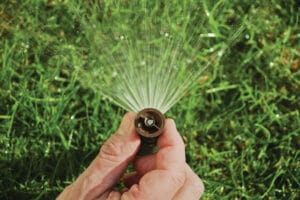- Water at the right time of day (between midnight and sunrise) from May to October. Watering when the sun is low and temperatures are cooler minimizes evaporation by as much as 30 percent.
- Water your lawn on a separate schedule from your plants, trees, and shrubs. Take into account the type of sprinkler, sun or shade exposure, soil type, and plant requirements
- Consider low-volume drip irrigation for plant beds and shrubbery. Install microirrigation for gardens, trees and shrubs to minimize evaporation and run-off.
- Have your sprinkler heads and drip emitters tested, maintained, and repaired regularly throughout the season
- Have your spray patterns modified by re-adjusting sprinkler heads for better direction or installing variable arc nozzles. Remove obstructions that prevent sprinklers from distributing water evenly and make sure you’re watering your lawn and plants, not sidewalks or buildings.
- Don’t water when it’s rainy. Call us to replace your irrigation clock with a “smart” clock or add a rain sensor. This inexpensive, money saving device will prevent watering in rainy weather

Why Use a Professional for Sprinkler System Maintenance?
Proper sprinkler system maintenance keeps your lawn or fire sprinkler system in top condition. However, maintaining these systems is easier said than done. They are





